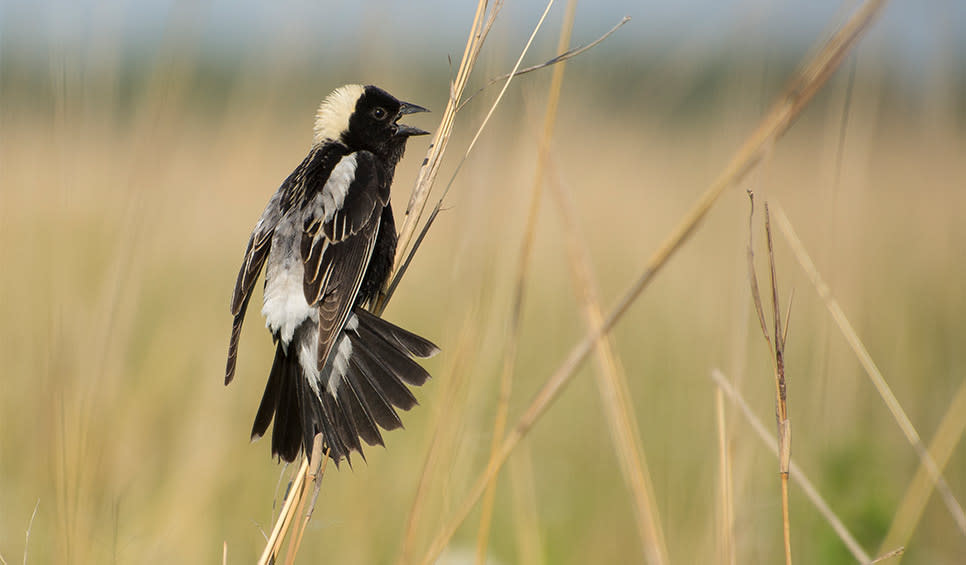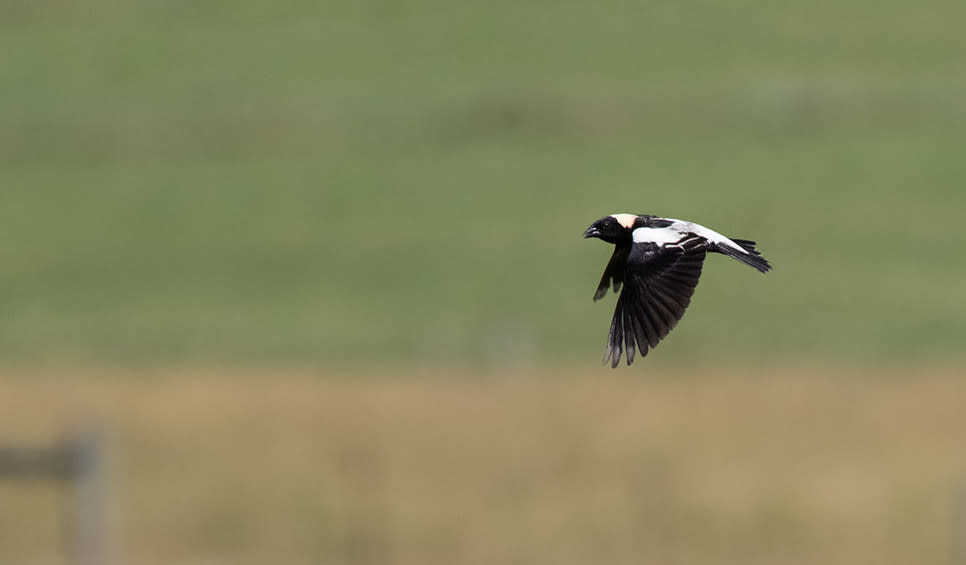Header photo by Gary Soper.
If you think saying the word “bobolink” is fun, you’d be right! Even more fun is seeing the bird itself.
It’s the male bobolink (Dolichonyx oryzivorus) that will turn your mind upside down. Many birds, such as bluebirds or chickadees, are dark on top and light underneath. This allows the birds to be better camouflaged against the light sky when viewed by predators from below, and more camouflaged against the dark earth when viewed from above.
This does not hold true for the male bobolink. In his breeding plumage, he is light on top and dark underneath, with a cream-colored patch on the backside of his head. You might think that he really wants to be seen!

Photo: Male bobolink by Chris Helzer
What’s amusing about seeing a male bobolink from far away is that our minds are so unaccustomed to seeing a bird that is light on top and dark underneath, that often when you see the bobolink flying, you mistake it, as I recently did even after all these years of working at Kankakee Sands, for a bird flying upside down!
The female and juvenile male bobolinks are much less showy. They look a lot like large sparrows -buff in color, brown mottling on their wings, a large pink-colored bill, and long-pointed wings. This fall, the ever-so-showy male bobolink will molt his attractive black and white feathers, and in their place will grow buff and brown feathers making him look much like the female and juvenile bobolinks.
Bobolinks are approximately seven inches in length with a wingspan of almost a foot and are in the same family, the Icterid family, as Baltimore orioles, eastern and western meadowlarks, red-winged blackbirds and brown-headed cowbirds. What you might notice about all these birds is that they are all medium-sized birds with long, thick, pointed bills and melodic songs.

Photo: Male bobolink by Kathy Malone
The male bobolink’s song is a lengthy, wide-ranging, bubbling, burbling song interspersed with short metallic sounding notes – kind of like his name if you say it over and over and over again: bobo-bobo-bobobobo-bobobo-link! He sings while perched, and unlike most birds, also sings while in flight! Don’t you agree that he is really wanting to be noticed?
All of this showing off that the male bobolink is doing is ultimately to attract a mate. Unlike most bird species, the male bobolink will have multiple mates. (House wren, red-winged blackbird and wild turkey also have several female partners.) What is even more rare is that the female also has multiple mates which translates into a nest full of eggs with different genetics.
Bobolinks are ground nesters. Females will create their nest at the base of a clump of vegetation in a meadow, prairie, open fallow field or agricultural field. You can imagine that mowing during the spring will likely end poorly for these ground nesting birds. According to the North American Breeding Bird Survey, between 1966 and 2015, bobolinks have declined in number 65%, due to nest destruction, habitat loss and habitat conversion.

Photo: Male bobolink by Kathy Malone
During the spring and summer, especially during the raising of young, bobolinks are feeding on seeds, insects and arachnids. During the winter months they are known to feed on grains such as rice, oats and corn, in addition to insects and agricultural weeds. It is their feeding on grains that has often gotten them shot as agricultural pests, further reducing their numbers.
Bobolinks summer in northern Indiana and northward, wintering in southern Indiana and south into South America.
The prairies at Kankakee Sands are home for bobolinks and other grassland birds whose numbers are also declining. Indeed, when Kankakee Sands was dreamed up all those years ago, grassland birds were one of our primary reasons for taking on this large-scale project. And now, after 20 years of planting prairies, we have rare grassland birds like the northern harriers and the Henslow’s sparrows in high numbers. That’s very exciting for all of us at The Nature Conservancy!
This year, several bobolinks are using Kankakee Sands as their summer home and your chances of seeing them are good. If you would like to take a short trip to the prairie to come see the upside-down looking male bobolink, try looking into the cattle pasture along CR 200 W, and even near the Kankakee Sands office around the bison pasture. Remember that bobolinks will be migrating south in the fall, so August is a great time to swing through to try to see them.
Visit Kankakee Sands soon to have your mind turned upside down. Or if the events of the past several months have already done that, let the wonders of nature turn your mind right side up!
The Nature Conservancy’s Kankakee Sands is an 8,300-acre prairie and savanna habitat in Northwest Indiana, open every day of the year for public enjoyment. For more information about Kankakee Sands, visit www.nature.org/KankakeeSands or call the office at 219-285-2184.



